Kentmere-100 胶片 官方冲洗数据
Kodak Ektachrome 100D彩色反转胶片5294 7294技术数据说明书
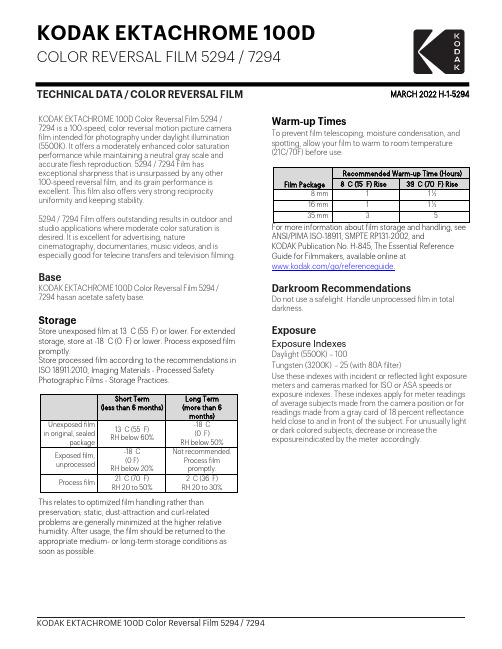
KODAK EKTACHROME 100DCOLOR REVERSAL FILM 5294 / 7294TECHNICAL DATA / COLOR REVERSAL FILM MARCH 2022H-1-5294 KODAK EKTACHROME 100D Color Reversal Film 5294 /7294 is a 100-speed, color reversal motion picture camerafilm intended for photography under daylight illumination(5500K). It offers a moderately enhanced color saturationperformance while maintaining a neutral gray scale andaccurate flesh reproduction. 5294 / 7294 Film hasexceptional sharpness that is unsurpassed by any other100-speed reversal film, and its grain performance isexcellent. This film also offers very strong reciprocityuniformity and keeping stability.5294 / 7294 Film offers outstanding results in outdoor andstudio applications where moderate color saturation isdesired. It is excellent for advertising, naturecinematography, documentaries, music videos, and isespecially good for telecine transfers and television filming.BaseKODAK EKTACHROME 100D Color Reversal Film 5294 /7294 has a n acetate safety base.StorageStore unexposed film at 13 C (55 F) or lower. For extendedstorage, store at -18 C (0 F) or lower. Process exposed filmpromptly.Store processed film according to the recommendations inISO 18911:2010, Imaging Materials - Processed SafetyPhotographic Films - Storage Practices.Short Term (less than 6 months)Long Term (more than 6 months)Unexposed film in original, sealedpackage13 C (55 F)RH below 60%-18 C(0 F)RH below 50%Exposed film, unprocessed-18 C(0 F)RH below 20%Not recommended.Process filmpromptly.Process film21 C (70 F)RH 20 to 50%2 C (36 F)RH 20 to 30%This relates to optimized film handling rather than preservation; static, dust-attraction and curl-related problems are generally minimized at the higher relative humidity. After usage, the film should be returned to the appropriate medium- or long-term storage conditions as soon as possible. Warm-up TimesTo prevent film telescoping, moisture condensation, and spotting, allow your film to warm to room temperature (21C/70F) before use:Film PackageRecommended Warm-up Time (Hours)8 C (15 F) Rise 39 C (70 F) Rise8 mm 1 1 ½16 mm 1 1 ½35 mm 3 5For more information about film storage and handling, see ANSI/PIMA ISO-18911, SMPTE RP131-2002, andKODAK Publication No. H-845, The Essential Reference Guide for Filmmakers, available online at/go/referenceguide.Darkroom RecommendationsDo not use a safelight. Handle unprocessed film in total darkness.ExposureExposure IndexesDaylight (5500K) – 100Tungsten (3200K) – 25 (with 80A filter)Use these indexes with incident or reflected light exposure meters and cameras marked for ISO or ASA speeds or exposure indexes. These indexes apply for meter readings of average subjects made from the camera position or for readings made from a gray card of 18 percent reflectance held close to and in front of the subject. For unusually light or dark colored subjects, decrease or increase the exposure i ndicated by the meter accordingly.Color BalanceThese films are balanced for exposure with daylight illumination (5500K). You can also expose them with tungsten lamps with the appropriate correction filters.1Daylight (5500 K)None 100 Metal HalideNone 100 H.M.I.None 100 KINO FLO KF55 None100 Tungsten (3000 K) WRATTEN2 Optical No.80A 25 Tungsten (3200 K) WRATTEN2 Optical No.80A 25 KINO FLO KF29 WRATTEN2 Optical No.80A 25 KINO FLO KF32 WRATTEN2 Optical No.80A 25 Fluorescent, WarmWhite WRATTEN2 CC40B& C C05C 40 Fluorescent, CoolWhiteWRATTEN2 CC20M801These are approximate corrections only.Note: Consult the manufacturer of high-intensity ultravioletlamps for safety information on ultraviolet radiation and ozone generation.Exposure Table-Daylight IlluminationAt 24 frames per second (fps), 170-degree shutter opening.Lens Aperture f/1.4 f/2 f/2.8 f/4 f/5.6 f/8 f/11 Footcandles Required25501002004008001600Based on 24 frames per second (fps), 170-degree shutter opening. At 18 frames per second (fps), use 3/4 of the footcandles (fc) shown.Reciprocity CharacteristicsYou do not need to make any filter corrections or exposure adjustments for exposure times from 1/10,000 to 1 second.ProcessingProcess this film in E-6 Chemicals, cine machine only.Note: KODAK EKTACHROME 100D Color Reversal Film 5294 /7294 contains special sensitizing and filter dyes that improve color reproduction. Because these dyes are designed to rinse out of the film during processing, they will change the color of the firstdeveloper, the reversal bath, the final wash, and the final rinse. This solution discoloration is only cosmetic. It will not affectsensitometry or the quality of any Process E-6 film or control material. However, the solutions will cause splicing tape andprocessing equipment (rollers, racks, etc.) to have a pinkish color. The pink dye residue can easily be washed off processing equipment by following the normal maintenance procedures.DuplicationMaking DuplicatesTo make color positive duplicates, scan the film images and output them KODAK VISION Color Print Film / 2383.IdentificationAfter processing, the product code numbers 5294 (35mm) or 7294 (16mm), emulsion and roll number information, KEYKODE numbers, and internal product symbol (EA) are visible along the length of the film, but when processed in a reversal process, the KEYKODE barcode will not read in barcode reading equipment. If the film is cross-processed in an ECN process, the KEYKODE barcodes should read properly.Image StructureFor more information on image-structure characteristics, see KODAK Publication No. H-845, The Essential Reference Guide for Filmmakers available online at /go/referenceguide .Modulation Transfer FunctionThe “perceived” sharpness of any film depends on various components of the motion picture production system. The camera and projector lenses and film printers, amongother factors, all play a role. But the specific sharpness of a film can be measured and charted in the Modulation Transfer Curve.This graph shows a measure of the visual sharpness of this film. The x-axis, “Spatial Frequency,” refers to the number of sine waves per millimeter that can be resolved. The y-axis, “Response,”corresponds to film sharpness. The longer and flatter the line, the more sine waves per millimeter that can be resolved with a high degree of sharpness — and the sharper the film.Note: These photographic modulation-transfer values were determined by using a method similar to the one described in ANSI Standard PH2.39-1977(R1992). The film was exposed with the specified illuminant to spatially varying sinusoidal test patterns having an aerial image modulation of a nominal 60 percent at the image plane, with processing as indicated. In most cases, the photographic modulation- transfer values are influenced by development-adjacency effects and are not equivalent to the true optical modulation-transfer curve of the emulsion layer in the photographic product.rms GranularityThe “perception” of the graininess of any film is highly dependent on scene content, complexity, color, and density. Other factors, such as film age, processing, exposure conditions, and telecine transfer may also have significant effects.Read with a microdensitometer, using a 48-micrometre aperture.To find the rms Granularity value for a given density, find the density on the left vertical scale and follow horizontally to the characteristic curve and then go vertically (up or down) to the granularity curve. At that point, follow horizontally to the Granularity Sigma D scale on the right. Read the number and multiply by 1000 for the rms value. Note: This curve represents granularity based on modified measuring techniques. Sensitometric and Diffuse RMS Granularity curves are produced on different equipment. A slight variation in curve shape may be noticed.The modulation-transfer curves, and the diffuse rms granularity data were generated from samples of 5294 / 7294 Film exposed with tungsten light filtered to 5500K and processed as recommended in Process E-6 chemicals. SensitometryThe curves describe this film's response to red, green, and blue light. Sensitometric curves determine the change in density on the film for a given change in log exposure.“0” on the x-axis represents normal exposure of an 18-percent gray card in the red, green, and blue layers of this film. A white card is 2 ⅓ stops higher than normal exposure.A 3-percent black card is 2 ⅔ stops below normal exposure.Spectral SensitivityThese curves depict the sensitivity of this film to the spectrum of light. They are useful for determining, modifying, and optimizing exposure for blue- and green-screen special-effects work.Spectral Dye-Density CurvesThese curves depict the spectral absorption of the dyes formed when the film is processed. They are useful for adjusting or optimizing any device that scans or prints the film.Note: Cyan, Magenta, and Yellow Dye Curves are peak-normalized.Note: The sensitometric curves and data in this publication represent product tested under the conditions of exposure and processing specified. They are representative of production coatings, and therefore do not apply directly to a particular box or roll of photographic material. They do not represent standards or specifications that must be met by Eastman Kodak Company. The company reserves the right to change and improve product characteristics at any time.Available Roll Lengths and FormatsSee Kodak Motion Picture Products Catalog at /go/mpcatalog To order film in the United States and Canada, call 1- 800-356-3259, prompt 3.Worldwide customers can find the nearest sales office at /go/salesofficesKODAK EKTACHROME 100D Color Reversal Film 5294 / 7294KODAK Publication No. H-1-5294 Kodak, Ektachrome, and Wratten and the Kodak logo are trademarks.Revised 3-22。
RT-100电阻率测试仪操作手册
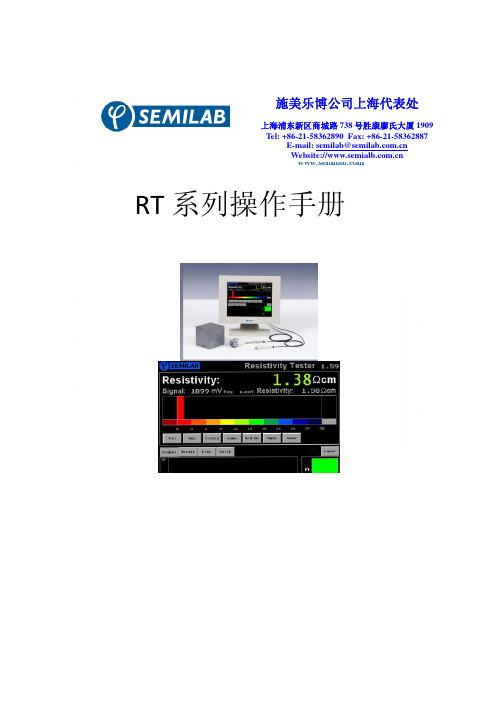
Semilab RT 系列电阻率测试设备主要包括:•Rt-100 电阻率测试仪无接触、无损伤、快速体电阻率测试:- 采用涡流场原理,测试体电阻率- 可以测量单晶、多晶,无需表面处理- 可用来分类测试锅底料、锭、棒、片等- 测试范围:0.5 – 20 ΩCM (选配功能:0.01 – 0.5 ΩCM) - 可选配无接触P/N型号测试•Rt-110 电阻率厚度测试仪无接触硅片体电阻率测试:- 采用涡流场原理,测试硅片的体电阻率- 电阻率范围:0.5 – 20 ΩCM (选配功能:0.01 – 0.5 ΩCM) - 精度: 2 ΩCM以下:3% 2 ΩCM以上:5%- 测试速度: 1s / 点- 可选加无接触电容法测硅片厚度功能- 可选配无接触硅锭、回炉料电阻率测试- 可选配无接触P/N型号测试I.原理Eddy current measurement 涡流法当通有交流电的圆形线圈靠接样品时,线圈中的磁场会在样品诱导形成环形的电流叫做涡流电流,涡流电流与样品的电导率成正比,涡流法测试实际上测试的是电流在样品中的损失。
系统的输出信号与功率成正比,功率用来保证振动的振幅恒定,此信号在电阻率为特定的值时最强,向大小两个方向减弱,因此两个不同的电阻率会对应一个相同的信号。
为进行区分,也需要对频率的去谐进行测试,低电阻率的样品去谐很明显,高电阻率的样品则不很明显,因此,去谐对对应相同信号的不同电阻率的样品有很好的区分度。
频率对涡流电流的反馈影响很大,一般选择在125-135MHz,这个频率适于测试0.5-25ohmcm的样品。
几何形状如样品不平或者尺寸很大,几何特性例如曲率,边缘等等。
会影响涡流电流的反馈。
如果涡流电流探头接触表面,几何的影响就会减小。
接近探头线圈越接近表面,对线圈的影响越大。
因此,当线圈与样品的距离增大时敏感度越低。
渗透深度因电流密度的分布,被测样品的表面反馈最强,随着深度增大而减小。
可以很方便的用数学计算来定义”标准注入深度”,即当涡流电流的值变为表面值的1/e时。
82种胶卷多指标对比评价
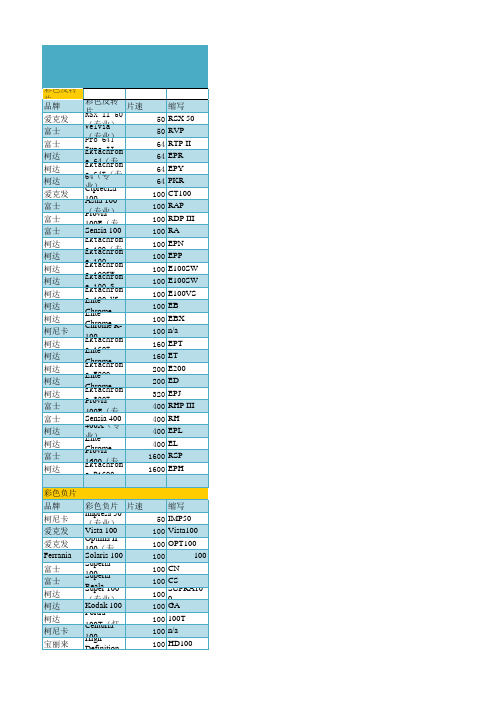
很高 高 高 高 很高 很高 高 高 高 高 高 高 高 高 高 高 高 中 高 高 高 高 很高 高 高 高 高 高 高 高 中 中偏高 中偏高 中偏高 高 高 高 高 高 中 中 中
高 中 很高 特高 高 高 很高 高 高 高 很高 很高 很高 高 很高 高 高 中 高 高 高 高 高 高 高 中偏高 特高 高 高 高 中 高 高 高 很高 高 高 高 很高 中 高 高
Portra 160 (专业) NPL160 (专业) NPS160 (专业) NPC160 (专业) Portra 160NC Portra 160VC PRO160 Vista 200 Optima II 200(专 Solaris 200 Superia 200 200 Kodak Royal Gold 200 Centuria 200 High Definition Vista 400 Optima II 400(专 Solaris 400 400NPH (专业) 快片400 (专业) X-TRA 400 400 Supra (专业) Kodak 400 Protra 400NC Protra 400VC Royal Gold 400 Centuria 400 Kodak 400 (专业) High Definition Vista 800 Solaris 800 NHG II 800(专 Press 800 (专业) Superia XTRA 800 Portrait NPZ 800 Supra 800 (专业) Portra 800 (专业) MAX Versatility Centuria 800 Gold Royal 1000 Supevia 1600 Press 1600 (专业)
82种胶卷多指标对比评价
评语 颗粒细,锐度好,拍摄明亮风光时灰色对比度平衡,也适合拍摄特写 颗粒细,色彩明亮,暖调肤色平衡好 钨丝灯光色温平衡,颗粒细微,适用于摄影室内拍摄人像或静物 曝光宽容度较宽,色彩明亮,颗粒细微,是专业摄影师喜爱的胶片 钨丝灯光色温平衡,适用于摄影室内拍摄人像或静物 颗粒细微,色彩真实,接近档案照片保存时间的要求。有业余型胶片的提供 锐度很好,色彩明亮,适用于拍摄人像、风光和档案文件 影调柔和,肤色自然,色彩明亮。适用于拍摄时装和产品 颗粒特细,色彩亮丽,适用于时装、风光和人像摄影 颗粒特细,适用于拍摄人像、自然风光、水下和特写,是Sensia II的重新命名 分辨率 很高 很高 高 高 高 高 高 很高 很高 很高 灰色对比度平衡,色彩真实,适用于要求严格的目录、翻拍录制 高 色彩真实,灰色对比度平衡。适用于拍摄人像、风光和静物 高 暖色调平衡好,适用于在多云的条件下拍摄人像、时装和建筑照片 很高 能提高色彩亮度,适用于时装、肖像摄影 很高 色彩逼真饱和,颗粒特细,可提高一级迫冲 很高 色调鲜艳,反差好,肤色表现优异,适合拍摄人像和风光 很高 同类片速中此型号的色彩饱和度特别好,适合拍自然风光 很高 拍摄阳光下的风光、建筑和产品的推荐胶片 高 钨丝灯光色温平衡胶片,适用于拍摄摄影室人像、产品和剧照 高 业余型钨丝灯光色温平衡胶片,适用于在3200K色温的灯光下拍摄 高 多功能胶片,色彩亮丽,反差适中,当ISO800片速拍摄时,效果仍然不错 高 中速胶片,是Elite400的翻版,色彩饱和度较高 高 高速,钨丝灯光源色温平衡,适用于现有光源拍摄舞台和人像 高 灰色对比度平衡,色彩明亮,是拍摄舞台、弱光下人像和体育的理想胶片 高 新款胶片,颗粒微细,色彩较Sensia II 400更好,适用于拍摄体育和舞台剧照,迫 高 冲效果也好 轻微暖调平衡,颗粒细 高 是Ektachrome 400X的业余型,微粒,灰色对比度平衡 高 为迫冲设计。适用于拍摄体育、舞台和弱光下风光照片 中 高速胶片,冲洗时需要迫冲才能达到ISO1600的曝光效果 中 锐度 很高 特高 高 高 高 特高 特高 很高 很高 很高 高 高 很高 很高 很高 很高 很高 高 高 高 高 高 高 高 高 高 高 中 中
日本TOYO ADVANTEC滤纸规格目录.doc

95
0.18
130
7.5
-
(中等)
-
2
-
滑表面,一般硬度.
No. 232 保留中等到中等细小微粒,慢 90
0.18
250
5.0
-
(中等/
-
6
-
流速,平滑表面,一般硬度.
中等细小)
No. 131 高保留效能,特别是对细小微 140
0.25
240
6.0
8
3
90
3
597
粒,如硫酸钡微晶,慢流速,平
(中等细小)
订货资料: 定量滤纸
• 可选直径(mm): 55, 70, 90, 110, 125, 150, 185, 240, 285, 300,330, 360, 400, 500 • 其它尺寸,请与我们联系 • 订购说明: 先填写“等级”,之后填写“直径”. 范例:(No.5A,125mm), (No.6,55mm) • 100张/盒
滑表面,一般硬度.
No. 235 最高保留效能,保留非常细小 95
0.17
1,200
4.0
- (非常细小) -
5
-
微粒,非常慢的流速,平滑表
面.
No. 101 保留大的微粒.
85
0.21
50
8.0
34
5
-
91
-
(粗糙和
凝胶状)
*1. 过滤时间 - 使用10cm2面积滤纸过滤100ml(20°C)蒸馏水的用时.(通过10cm高,10cm2面积的圆柱型水柱提供的压力) *2. 吸水速度 - 在20°C把一条垂直滤纸放在蒸馏水中,10分钟之后蒸馏水能到达的距离. *3. 湿润破裂强度 - 滤纸浸泡水之后,使用 Mullen 爆裂强度计进行测试. *4. 和其它产商的比对不是绝对的,只用作参考.
胶卷冲洗数据速查表
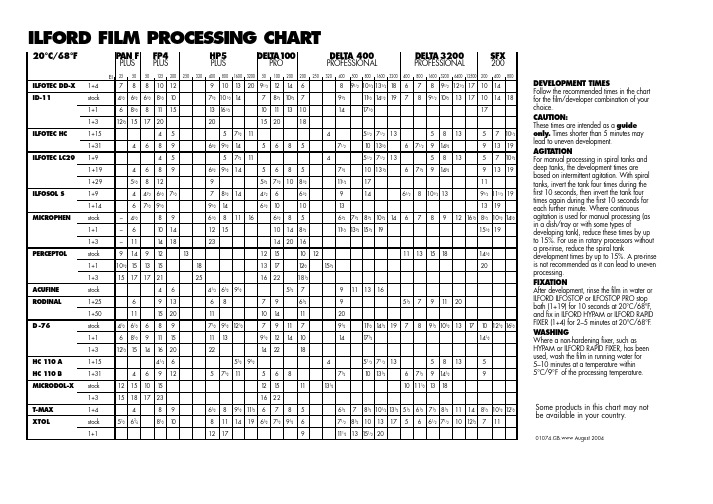
ILFORD FILM PROCESSING CHART 20°C/68°F P AN F FP4HP5 DEL T A100DELT A 400DELT A 3200SFX PLUS PLUS PLUS PRO PROFESSIONAL PROFESSIONAL 20025505012520025032040080016003200501002002002503204005008001600320040080016003200640012500200400800ILFOTEC DD-X 1+47881012910132091/212146891/2101/2131/21867891/2121/2171014ID-11stock 41/261/261/281/21071/2101/214781/2101/2791/2111/2141/2197891/2101/213171014181+1681/28111513161/21011131014171/2171+3121/215172020152018ILFOTEC HC 1+1545571/211451/271/213581357101/21+31468961/291/214568571/210131/2671/29141/291319ILFOTEC LC291+945571/211451/271/213581357101/21+19468961/291/214568571/210131/2671/29141/2913191+2951/2812951/271/21081/2111/21711ILFOSOL S 1+9441/261/271/2781/21441/2661/291461/28101/21391/2111/2191+14671/291/291/21461/21010131319MICROPHEN stock –41/28961/28111661/28561/271/281/2101/214678912161/281/2101/2141/21+1–610141215101481/2111/2131/2151/219151/2191+3–11141823142016PERCEPTOL stock 914912131215101211131518141/21+1101/2151315181317121/2151/2201+315171721251622181/2ACUFINE stock 4641/261/291/251/279111316RODINAL 1+256913687961/2951/27911201+501115************D-76stock 41/261/268971/291/2121/27911791/2111/2141/2197891/2101/2131710121/2161/21+1681/291115111391/212141014171/2141/21+3121/21514162022142218HC 110A 1+1541/2651/291/2451/271/21358135HC 110B 1+3146912571/21156871/210131/2671/29141/29MICRODOL-X stock 12151015121511131/210111/213181+3151817231622T -MAX 1+448961/2891/2111/2678561/2781/2101/2131/251/261/271/281/2111481/2101/2121/2XTOL stock 51/263/481/210811141961/271/291/2671/281/21013175661/271/210121/27111+112179111/213151/220EI DEVELOPMENT TIMES Follow the recommended times in the chart for the film/developer combination of your choice.CAUTION:These times are intended as a guide only .Times shorter than 5 minutes may lead to uneven development.AGIT A TION For manual processing in spiral tanks and deep tanks, the development times are based on intermittent agitation. With spiral tanks, invert the tank four times during the first 10 seconds, then invert the tank four times again during the first 10 seconds for each further minute. Where continuous agitation is used for manual processing (as in a dish/tray or with some types of developing tank), reduce these times by up to 15%. For use in rotary processors without a pre-rinse, reduce the spiral tank development times by up to 15%. A pre-rinse is not recommended as it can lead to uneven processing.FIXA TION After development, rinse the film in water or ILFORD ILFOSTOP or ILFOSTOP PRO stop bath (1+19) for 10 seconds at 20°C/68°F ,and fix in ILFORD HYPAM or ILFORD RAPID FIXER (1+4) for 2–5 minutes at 20°C/68°F .W ASHING Where a non-hardening fixer, such as HYPAM or ILFORD RAPID FIXER, has been used, wash the film in running water for 5–10 minutes at a temperature within 5°C/9°F of the processing temperature.Some products in this chart may not be available in your country.01074.GB.www August 2004。
柯达胶片
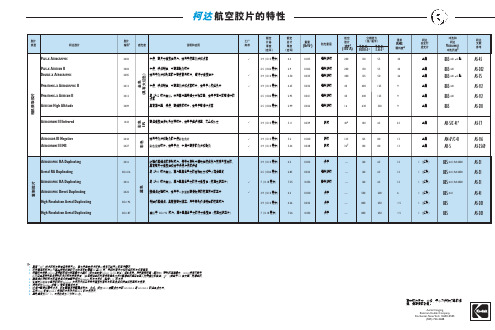
√
7(0.18 毫米)
7.35
0.054
着色明胶
—
160
63
12
超精细纹理胶片,适用于一步复制高清晰度的航空底片或正片
√
3.9(0.10 毫米)
4.2
0.030
快干
—
500
200
6
颗粒极其精细,具有超高分辨率,用于复制极细颗粒的航空胶片
3.9(0.10 毫米)
4.26
5
表I 具有 ESTAR 片基的黑白胶片
三种不同厚度的 ESTAR 片基 (2.5 密耳、3.9 密耳、7 密耳)导致卷在标准航空胶片卷筒上的胶片长度也各不相 同。下面的部件列表说明了每种类型的胶片提供的标准长度。
胶片 规格 编号
4922 4932 4942 5332 536
5272 514 5282 530 5352
50 英尺 100 英尺 200 英尺 500 英尺 500 英尺
40 英尺 75 英尺 150 英尺 350 英尺 350 英尺
—
— 100 英尺 200 英尺 200 英尺
70 毫米 70 毫米 70 毫米 70 毫米 70 毫米
1,000 英尺 1,000 英尺 2,000 英尺 2,000 英尺
931 991 883 8973
884 8983 886 8993
949 952 9814 955
957 961 960
胶片 宽度
胶片长度 ( 无 导 片 或 拖 片)
ESTAR 薄 片基
( 2.5 密 耳)
ESTAR 片基 ( 3.9 密 耳)
ESTAR 厚 片基
(7 密 耳)
70 毫米 70 毫米 70 毫米 70 毫米 70 毫米
黑白胶片摄影与冲洗指南

黑白胶片摄影与冲洗指南说黑白摄影难,是因为黑白摄影完全是靠明暗来表达画面,而彩色摄影还有色彩,于是黑白摄影比彩色少了一个表达手段,所以出好片难一张还过得去的彩色照片,如果要用黑白底片来拍摄,那就很可能是废片.(如图1):图1里面彩色的花,还算红绿对比分明,颇为艳丽,但是如果用黑白胶片去拍摄,那就成了一团杂草了。
往往人眼看着觉得很不错的一个场景,拿黑白胶片拍出来就什么都不是。
如果你手头有一台数码相机的话,那么不妨用黑白模式来尝试一下。
所以,黑白摄影,首要就是要有足够的明暗对比:黑的足够黑,白的足够白,否则灰蒙蒙的照片会让人昏昏欲睡。
发现这样的场景有一个窍门,就是观察场景中有没有足够的特别明亮的区域(比如一束明亮的阳光,特别洁白的沙发)或者特别黑暗的区域(比如黑色的塑料,深色的家具),如果存在这样的区域,那么这个场景就比较容易拍出明朗清晰黑白照片了。
明显能看出,图2比图3更加的吸引注意力,也更有冲击力和表现力。
另外,要想用黑白胶片拍出好片,你还需要了解以下几个概念:第一个基础概念是反差,反差是黑白胶片摄影最重要的一个概念,往往一张片子的好坏,就全凭反差控制,反差,就是胶片表现明暗层次的能力,比如最黑的部分是全黑,稍亮一些的是深灰,然后是再浅一些的灰,亮度逐级递增,直到最亮的纯白,形成了一系列如同阶梯似的明暗条纹,阶梯越多的,就是反差小的,阶梯越少的,就是反差大的,如图4:高反差的特点就是黑白之间有强烈差别,黑就是黑,白就是白,非常清晰,而低反差的特点就是黑色不怎么黑,白色也不怎么白,有一点灰蒙蒙。
所以高反差对比强烈,会带来较为明朗的画面,而低反差则会带来细腻的材质表现。
通常而言,高反差的照片会更好看一些。
第二个基础概念是颗粒,胶片上的卤化银颗粒感光后发生了一些结构变化,并聚集在一起,就形成了不透光的一些极小的斑块,这些斑块形成了我们看到的图像(听起来就如同数码相机的像素一样),这就是我们所称的“颗粒”颗粒越粗,画面就越难看,仿佛有一层麻点。
胶片正史
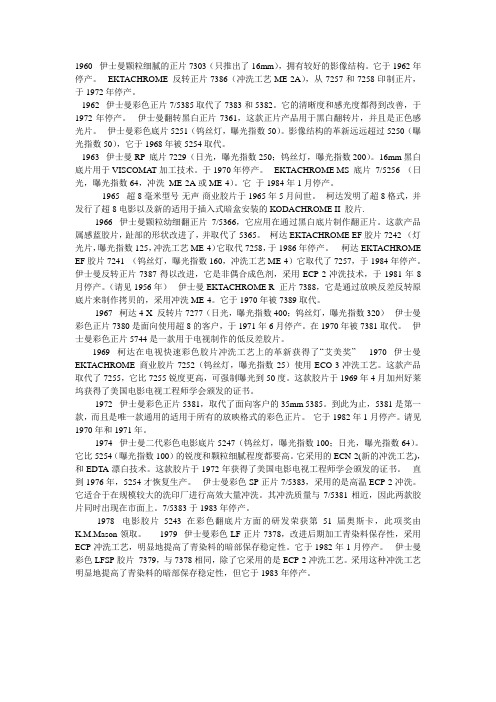
1960 伊士曼颗粒细腻的正片7303(只推出了16mm),拥有较好的影像结构。
它于1962年停产。
EKTACHROME 反转正片7386(冲洗工艺ME-2A),从7257和7258印制正片,于1972年停产。
1962 伊士曼彩色正片7/5385取代了7383和5382。
它的清晰度和感光度都得到改善,于1972年停产。
伊士曼翻转黑白正片7361,这款正片产品用于黑白翻转片,并且是正色感光片。
伊士曼彩色底片5251(钨丝灯,曝光指数50)。
影像结构的革新远远超过5250(曝光指数50),它于1968年被5254取代。
1963 伊士曼RP 底片7229(日光,曝光指数250;钨丝灯,曝光指数200)。
16mm黑白底片用于VISCOMA T加工技术。
于1970年停产。
EKTACHROME MS 底片7/5256 (日光,曝光指数64,冲洗ME-2A或ME-4)。
它于1984年1月停产。
1965 超8毫米型号-无声-商业胶片于1965年5月问世。
柯达发明了超8格式,并发行了超8电影以及新的适用于插入式暗盒安装的KODACHROME II 胶片.1966 伊士曼颗粒幼细翻正片7/5366,它应用在通过黑白底片制作翻正片。
这款产品属感蓝胶片,趾部的形状改进了,并取代了5365。
柯达EKTACHROME EF胶片7242 (灯光片,曝光指数125,冲洗工艺ME-4)它取代7258,于1986年停产。
柯达EKTACHROME EF胶片7241 (钨丝灯,曝光指数160,冲洗工艺ME-4)它取代了7257,于1984年停产。
伊士曼反转正片7387得以改进,它是非偶合成色剂,采用ECP-2冲洗技术,于1981年8月停产。
(请见1956年) 伊士曼EKTACHROME R 正片7388,它是通过放映反差反转原底片来制作拷贝的,采用冲洗ME-4。
它于1970年被7389取代。
1967 柯达4-X 反转片7277(日光,曝光指数400;钨丝灯,曝光指数320) 伊士曼彩色正片7380是面向使用超8的客户,于1971年6月停产。
奔图Pantum M6200-6500系列维修手册
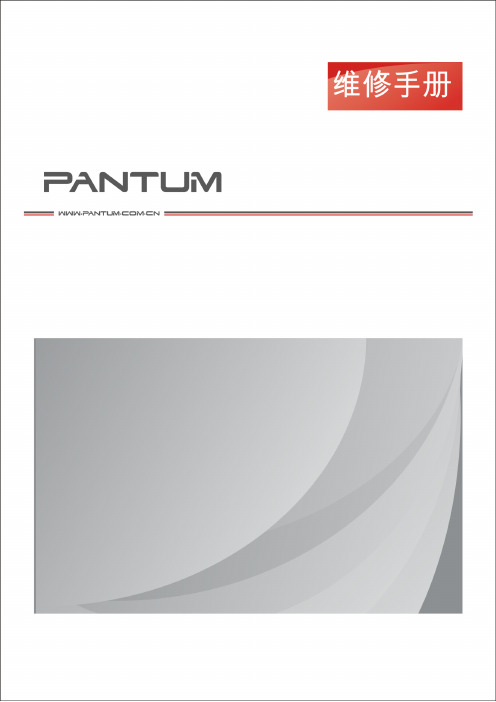
奔图激光多功能一体机维修手册产品型号:M6500/M6500N/M6500NWI法律说明商标Pantum和Pantum标识是珠海赛纳打印科技股份有限公司注册的商标。
Microsoft、Windows、Windows server和Windows Vista是微软公司在美国和/或其他国家注册的商标和注册商标。
对于本手册涉及的软件名称,其所有权根据相应的许可协议由所属公司拥有。
本手册涉及的其他产品和品牌名称为其相应所有者的注册商标、商标或服务标志。
版权本手册版权归珠海赛纳打印科技股份有限公司所有。
未经珠海赛纳打印科技股份有限公司事先书面同意,禁止以任何手段或形式对本手册进行复印、翻译、修改和传送。
版本:V 1.0免责声明珠海赛纳打印科技股份有限公司保留对本手册作出更改的权利。
如有更改,恕不另行通知。
用户未按手册操作而产生的任何损害,由用户本人承担。
同时,珠海赛纳打印科技股份有限公司除了在产品维修手册或服务承诺作出的明示担保外,未对本手册(包括排版或文字)作出任何明示或默示的担保或保证。
本产品被用于某些文档或图像的复印、打印、扫描或其他形式时,可能违反您所在地的法律。
您如果无法确定该使用是否符合所在地法律时,应向法律专业人士咨询后进行。
II安全信息在开始维修工作之前,请仔细阅读并理解下述安全和警告事项。
重要注意事项由于可能出现非专业人员维修而损坏本产品的风险,奔图公司强烈建议:应由经过奔图公司培训的技术人员来维修。
在维修本手册中规定的产品或零部件时,用户必须承担人身伤害和损坏本产品的风险,因此,在进行维修工作之前,须仔细阅读本维修手册,以便能够正确的操作和维护本产品。
请妥善保管本维修手册,以备将来维修之用。
警告、注意和注释的说明:* 请遵守警告,以防造成人身伤害。
* 请遵守警告,正确维修打印机,以防损坏。
* 当维修打印机时请注意和相关提示。
* 以下列出的是本手册中的各种“警告”信息。
III将本设备放置在一个平整、牢固而不易振动和受到撞击的表面上,如桌面。
柯达E-6 彩色反转片冲洗工艺和配方
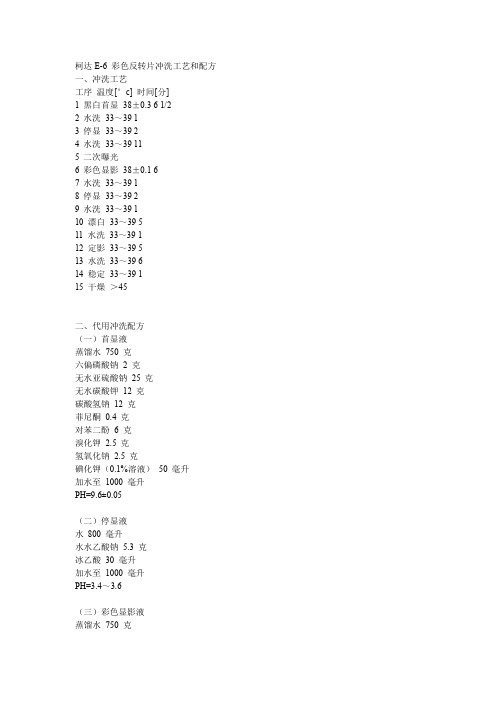
柯达E-6 彩色反转片冲洗工艺和配方一、冲洗工艺工序温度[°c] 时间[分]1 黑白首显38±0.3 6 1/22 水洗33~39 13 停显33~39 24 水洗33~39 115 二次曝光6 彩色显影38±0.1 67 水洗33~39 18 停显33~39 29 水洗33~39 110 漂白33~39 511 水洗33~39 112 定影33~39 513 水洗33~39 614 稳定33~39 115 干燥>45二、代用冲洗配方(一)首显液蒸馏水750 克六偏磷酸钠 2 克无水亚硫酸钠25 克无水碳酸钾12 克碳酸氢钠12 克菲尼酮0.4 克对苯二酚 6 克溴化钾 2.5 克氢氧化钠 2.5 克碘化钾(0.1%溶液)50 毫升加水至1000 毫升PH=9.6±0.05(二)停显液水800 毫升水水乙酸钠 5.3 克冰乙酸30 毫升加水至1000 毫升PH=3.4~3.6(三)彩色显影液蒸馏水750 克软水剂 1 克十二水磷酸三钠40 克氢氧化钠 3 克无水亚硫酸钠 4.5 克溴化钾0.6 克碘化钾(0.1%溶液)30 毫升硫酸氢钠 1.25 克柠嗪酸 1.25 克CD-3 11.3 克(用CD-4时为7克)加水至1000 毫升PH=11.55±0.05(四)漂白液水750 毫升铁氰化钾112 克溴化钾24 克十二水磷酸氢二钠62 克磷酸二氢钾15.6 克硫氰酸钠10 克加水至1000 毫升PH=6.6~7(五)定影液水600 毫升硫代硫酸钠160 克磷酸二氢钠10 克加水至1000 毫升PH=6.9~7注:硫代硫酸钠也可以用120可用硫代硫酸铵代替。
磷酸二氢钠在该定影液中也可以不加。
(六)稳定液水800 毫升甲醛(37~40%) 3 毫升润湿剂(10%溶液)10 毫升加水至1000 毫升注:此配方和工艺对加工冲洗业余反转片可取得良好效果。
对冲洗专业反转片有时偏蓝。
针孔照相机的设计、制作和使用
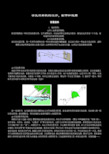
针孔照相机的设计、制作和使用背景资料1.知识背景:①什么是针孔照相机:针孔照相机是一种古老的成像工具,它不需要镜头、反光镜或其它任何光学部件,而是让光线穿过一个小孔,在暗箱形成外部景物的倒像。
②小孔成像基本原理:在较暗的屋子里,把一支点燃的蜡烛放在一块半透明的塑料薄膜前面,在它们之间放一块钻有小孔的纸板。
塑料薄膜上就出现烛焰的倒立的像(见图),这种现象表明了光沿直线传播,这就是小孔成像基本原理。
③小孔成像实例:在自然界中也常常可以观察到小孔所成的像。
当灿烂的阳光透过浓密的树叶斜射在地面上的时候,你会在地面上看到许多摇曳的光斑。
有趣的是不管树叶交织成的小孔是什么形状,每个光斑都是圆的,这是为什么呢?原来,这是太阳穿过小孔所成的像。
太阳是一个球体,所以它的像总是圆的。
要是某一天发生了日偏食,太阳缺了一部分,那时候才会形成许多奇异的月牙形的光斑(见图)在一定的时刻,光线通过隧道在对面的山上会形成倒置的影像。
在生活中也可以看到小孔成像,当你进入到一间较暗的房间,通过钥匙孔,可以在墙壁上看到外面投入的倒置影像。
④小孔成像历史沿革:我国古代在公元前4世纪,墨翟就做过针孔成像的实验,并给予分析和解释。
《墨经》中明确地写道:"景到(倒),在午有端,与景长,说在端。
"这里的" 午"即小孔所在处。
这段文字表明小孔成像的是倒像,其原因是在小孔处光线交叉的地方有一点("端"),成像的大小,与这交点的位置无关。
从这里也可以清楚看到,古人已经认识到光是直线行进的,所以常用"射"来描述光线径直向前。
北宋的沈括在《梦溪笔谈》中也记述了光的直线传播和小孔成像的实验。
他首先直接观察在空中飞动,地面上的影子也跟着移动,移动的方向与飞的方向一致。
然后在纸窗上开一小孔,使窗外飞鸢和楼塔的影子呈现在室内的纸屏上面,沈括用针孔成像的原理来解释所观察到的结果:若鸢飞空中,其影随鸢而移,或中间为窗所束,则影与鸢相连,鸢东则影西,鸢西则影东。
Elotex ERA100 安全说明书
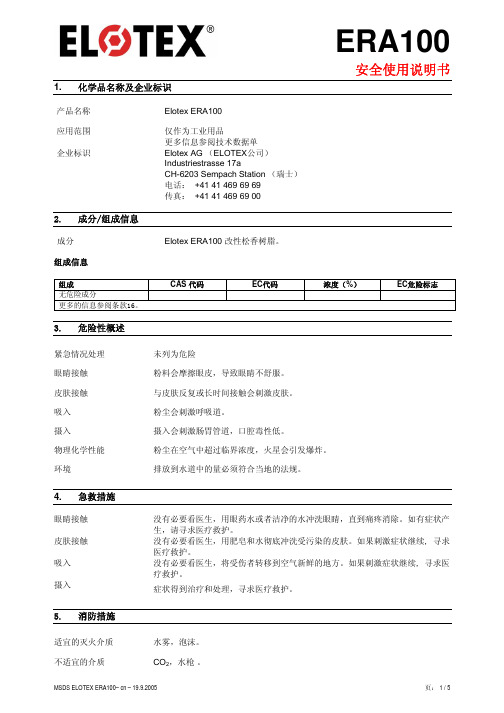
1. 化学品名称及企业标识产品名称Elotex ERA100应用范围仅作为工业用品更多信息参阅技术数据单(ELOTEX公司)AG企业标识 ElotexIndustriestrasse 17aCH-6203 Sempach Station (瑞士)电话: +41 41 469 69 69传真: +41 41 469 69 002.成分/组成信息成分 Elotex ERA100 改性松香树脂。
组成信息组成 CAS代码 EC代码浓度(%) EC危险标志无危险成分更多的信息参阅条款16。
3.危险性概述紧急情况处理未列为危险眼睛接触粉料会摩擦眼皮,导致眼睛不舒服。
皮肤接触与皮肤反复或长时间接触会刺激皮肤。
吸入粉尘会刺激呼吸道。
摄入摄入会刺激肠胃管道,口腔毒性低。
物理化学性能粉尘在空气中超过临界浓度,火星会引发爆炸。
环境排放到水道中的量必须符合当地的法规。
4. 急救措施眼睛接触 没有必要看医生,用眼药水或者洁净的水冲洗眼睛,直到痛疼消除。
如有症状产生,请寻求医疗救护。
皮肤接触 没有必要看医生,用肥皂和水彻底冲洗受污染的皮肤。
如果刺激症状继续, 寻求医疗救护。
吸入 没有必要看医生,将受伤者转移到空气新鲜的地方。
如果刺激症状继续, 寻求医疗救护。
摄入 症状得到治疗和处理,寻求医疗救护。
5.消防措施适宜的灭火介质水雾,泡沫。
不适宜的介质 CO2,水枪。
特殊装备消防员应配备空气呼吸器。
消防装备消防员应配备装备以防备有毒物质和刺激的烟雾。
火灾和爆炸的危险产品为粉末状的易燃性物质,有潜在的火灾危险。
粉尘的浓度要低于爆炸下限浓度,要避免烟火,避免火星和静电。
在高温下,产品会产生少量的有机挥发性物质。
燃烧生成的有毒物质燃烧会生成一氧化碳,二氧化碳以及其他碳氢化和物。
6. 泄漏应急处理处理溢出和泄漏产品防止在空气中弥散,去除火源。
湿润泄漏的材料,回收到垃圾箱。
根据地方,省或者国家法规进行清扫和处理。
禁止粉尘进入排水系统和河道。
TMAX黑白冲洗步骤及各配方

TMAX黑白冲洗步骤及各配方
tmax100,20度,d—76配方
1,预备水溶 1分
2,显影 9分
3,停显 30秒
4,定影 5-10分
5,水洗 30分
6,坚膜 1分
7,干燥
8,装袋
显影液配方:
蒸馏水750毫升(52度)
甲氨基酚(米吐儿) 2克
无水亚硫酸钠 100克
对苯二酚 5克
四硼酸钠(硼砂)2克
加水至 1000毫升
原液使用
停显液配方:
蒸馏水750毫升
醋酸(28%) 48毫升
加水至 1000毫升
定影液配方:
蒸馏水750毫升(52度)硫代硫酸钠(海波)240克无水亚硫酸钠 15克
醋酸(28%) 48毫升
加水至 1000毫升
坚膜液配方:
蒸馏水500毫升
甲醛(37%溶液) 10毫升碳酸钠(干粉)6克
加水至1000毫升
搅动方法:
预漂连续搅动30秒
显影开始连续搅动30秒,然后每一分钟搅动5秒定影开始连续搅动1分钟,然后每一分钟搅动5秒坚膜静止不动,不要起泡。
kodak柯达黑白胶卷官方冲洗数据
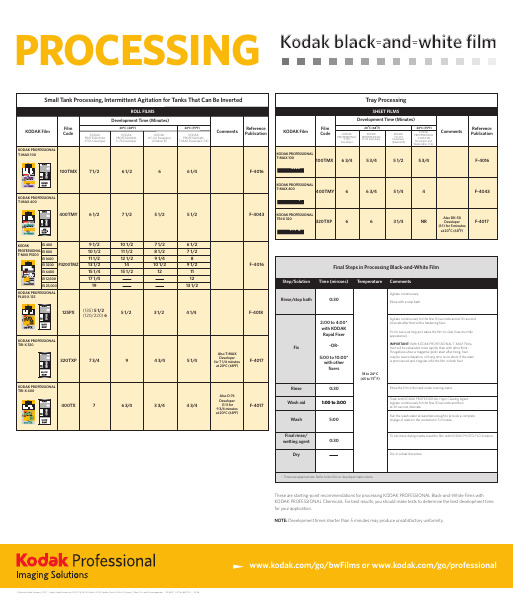
PROCESSING Kodak black-and-white film
Small Tank Processing, Intermittent Agitation for Tanks That Can Be Inverted
KODAK Film
Film Code
KODAK PROFESSIONAL T-MAX 100
Fix
Rinse Wash aid
Wash
2:00 to 4:00* with KODAK Rapid Fixer
-OR5:00 to 10:00*
with other fixers
0:30
1:00 to 2:00
5:00
Agitate continuously for the first 30 seconds and at 30-second intervals after that with a hardening fixer.
KODAK PROFESSIONAL XTOL Developer
ROLL FILMS
Development Time (Minutes)
200C (680F)
KODAK PROFESSIONAL D-76 Developer
KODAK HC-110 Developer
(Dilution B)
240C (750F)
T-MAX 400
400TMY 6
6 3/4
5 1/4
4
F-4043
F-4043
KODAK PROFESSIONAL
TRI-X 320
320TXP
6
Also DK-50
6
柯达专业EKTAR 100胶卷技术数据说明书

February 2016 • E-4046TECHNICAL DATA / COLOR NEGATIVE FILMKODAK PROFESSIONAL EKTAR 100 FilmKODAK PROFESSIONAL EKTAR 100 Film is the world's finest grain color negative film. With ISO 100 speed, high saturation and ultra-vivid color, this film offers the finest, smoothest grain of any color negative film available today. An ideal choice for commercial photographers andadvanced amateurs, KODAK PROFESSIONAL EKTAR 100 Film is recommended for applications such as nature, travel and outdoor photography, as well as for fashion and product photography.SIZES AVAILABLEAvailability may differ from country to country. See your dealer who supplies KODAK PROFESSIONAL Products.TECHNOLOGYBENEFIT•Incorporates EntertainmentImaging’s KODAK VISION Film technology•Micro-Structure Optimized KODAK T-GRAIN Emulsions•KODAK Proprietary Advanced Development Accelerators •World's finest-grained color negative film •Ideal for scanning •Extraordinary enlargement capability from a 35mmnegative •Optimized Emulsion Spectral Sensitivity and Image Modifier Chemistry•Ultra-vivid color•KODAK Advanced Cubic Emulsions •KODAK Proprietary DI R Couplers•Optimized sharpness •Distinct edges, fine detail •Unified Emulsion Technology•Printing compatible with other KODAK FilmsSize/FormatCode Base13551100.13 mm (0.005 inch)acetate 12061100.10 mm (0.004 inch)acetate Sheets0.19 mm (0.007 inch) KODAK ESTAR Thick BaseSTORAGE AND HANDLINGStore unexposed film at 21°C (70°F) or lower in the original sealed package. For extended periods, store film at 13°C (55°F) to preserve consistency.To avoid moisture condensation on film that has been refrigerated, allow the film to warm up to roomtemperature before opening the package. Typical warm-up times are given in the table below.Load and unload roll-film cameras in subdued light. Total darkness is required when you load and unload sheet film holders.Process film as soon as possible after exposure. Protect negatives from strong light, and store them in a cool, dry place. For long-term storage, keep negatives at atemperature between 2°C (35°F) and 13°C (55°F) and at a relative humidity between 30 and 35percent.DARKROOM RECOMMENDATIONSDo not use a safelight. Handle unprocessed film in total darkness.EXPOSUREFilm SpeedUse the speed numbers in the tables below with cameras or meters marked for ISO, ASA, or DIN speeds or exposure indexes (EIs). Do not change the film-speed setting when metering through a filter. Metering through filters may affect light meter accuracy; see your meter or camera manual for specific information. For critical work, make a series of test exposures.* For best results without special printing.SizeWarm-Up Times (Hours) to Reach Room T emperature of 21°C (70°F) From a StorageT emperature of:-18°C (0°F)2°C (35°F)13°C (55°F)135 magazine 11⁄211⁄4112013⁄41⁄210-sheet box11⁄211Light Source KODAK WRATTEN Gelatin FilterISO Speed Daylight or Electronic FlashNone 100Photolamp (3400 K)No. 80B 32Tungsten (3200 K)No. 80A25DaylightUse the exposures in the table below for average frontlit subjects from 2hours after sunrise to 2hours before sunset.* Use f/5.6 for backlit close-up subjects.† Use f/8 for backlit close-up subjects.‡ Subject shaded from the sun but lighted by a large area of sky.Adjustments for Long and Short ExposuresNo filter correction or exposure compensation is required for exposures from 1⁄10,000second to 1 second. Forcritical applications with longer exposure times, make tests under your conditions.Electronic FlashUse the appropriate guide number in the table below as starting-point recommendations for your equipment. Select the unit output closest to the number given by your flash manufacturer. Then find the guide number for feet or metres. T o determine the lens opening, divide the guide number by the flash-to-subject distance. If negatives are consistently too dense (overexposed), use a higher guide number; if they are too thin (underexposed), use a lower number.* BCPS = beam candlepower secondsLighting ConditionsShutter Speed (second)and Lens OpeningBright or Hazy Sun on Light Sand or Snow1/125f /16Bright or Hazy Sun (Distinct Shadows)1/125f /11*Weak, Hazy Sun (Soft Shadows)1/125f /8Cloudy Bright (No Shadows)1/125f /5.6Heavy Overcast or Open Shade ‡1/125f /4Unit Output (BCPS)*Guide NumberDistances in Feet/Metres35040/1250050/1570060/18100070/21140085/262000100/302800120/364000140/425600170/508000200/60Fluorescent and High-Intensity Discharge LampsUse the color-compensating filters and exposure adjustments in the tables below as starting points to expose KODAK PROFESSIONAL EKTAR 100Film under fluorescent or high-intensity discharge lamps. For critical applications, make a series of test exposures under your actual conditions.To avoid the brightness and color variations that occur during a single alternating-current cycle, use exposure times of 1⁄60second or longer with fluorescent lamps; with high-intensity discharge lamps, use exposure times of 1⁄125second or longer.PROCESSINGProcess EKTAR 100 Film in KODAK FLEXICOLORChemicals for Process C-41 using the replenishment and wash rates in the tables below. Note that the developer replenishment rates are starting-point recommendations only and may vary due to the amount of exposure to the film, scene content, and the presence/absence of sprocket holes.Replenishment and Wash Rates* Rates are for first wash and a two-stage countercurrent final wash. Doublethese rates for a single stage final wash.Type of Fluorescent Lamp KODAK Color Compensating Filter(s)Exposure Adjustment Daylight 20R + 5M +1 stop White 40B + 5C +1 2/3 stop Warm White 40B + 40C +2 stops Warm White Deluxe 40B + 50C +2 stops Cool White 30B +1 stop Cool White Deluxe40C + 10M +1 stopHigh-Intensity DischargeLamp (CCT)KODAK Color Compensating Filter(s)Exposure Adjustment High-Pressure Sodium Vapor 50B + 70C +2 2/3 stops Metal Halide 5C + 10M +2/3 stop Mercury Vapor with Phosphor30B + 5C +1 stop Mercury Vapor without Phosphor80R+1 2/3 stopFilm SizeKODAK FLEXICOLOR Developer Replenisher KODAK FLEXICOLOR Developer Replenisher LORR KODAK FLEXICOLOR Bleach III, Fixer, and Stabilizer Wash Water *1351012 mL/m 294 mL/ft 2506 mL/m 247 mL/ft 2861 mL/m 280 mL/ft 231 L/m 22.9 L/ft 21201012 mL/m 294 mL/ft 2506 mL/m 247 mL/ft 21023 mL/m 2107 mL/ft 231 L/m 22.9 L/ft 24 x 51012 mL/m 294 mL/ft 2506 mL/m 247 mL/ft 21023 mL/m 2107 mL/ft 231 L/m 22.9 L/ft 28 x 101012 mL/m 294 mL/ft 2506 mL/m 247 mL/ft 21023 mL/m 2107 mL/ft 231 L/m 22.9 L/ft 2JUDGING NEGATIVE EXPOSURESYou can check the exposure level with a suitable electronic densitometer equipped with a filter such as a KODAK WRATTEN Gelatin Filter No.92 or the red filter forStatus M densitometry. Depending on the subject and the light source used for exposure, a normally exposed and processed color negative measured through the red filter should have the approximate densities listed below.Because of the extreme range in skin color, use these red density values for a normally lit forehead only as a guide. For best results, use a KODAK Gray Card (gray side).RETOUCHINGYou can retouch the 120 and sheet sizes on both the base side and the emulsion side. Retouch only the emulsion side of 135size film.PRINTING NEGATIVESThis film is optimized for printing to —KODAK PROFESSIONAL ENDURA Premier Paper KODAK PROFESSIONAL ENDURA Premier Canvas PaperKODAK PROFESSIONAL ENDURA Premier Metallic PaperKODAK PROFESSIONAL ENDURA Transparency Display MaterialKODAK PROFESSIONAL ENDURA Clear Display MaterialSCANNING NEGATIVESYou can easily scan EKTAR 100 Film negatives with avariety of linear-array-CCD, area-array-CCD, and PMT film scanners. You can scan negatives on desktop scanners as well as high-end drum scanners.Area MeasuredDensity Reading KODAK Gray Card (gray side) receiving same illumination as subject0.77 to 0.87Lightest step (darkest in the negative) of a KODAK Paper Gray Scale receiving same illumination as subject1.13 to 1.23Highest diffuse density on normally lighted forehead—light complexion —dark complexion1.08 to 1.180.93 to 1.03IMAGE STRUCTUREPrint Grain IndexThe Print Grain Index number refers to a method of defining graininess in a print made with diffuse-printing illumination. It replaces rms granularity and has a different scale which cannot be compared to rms granularity.•The method uses a uniform perceptual scale, with a change of four units equaling a just noticeable difference in graininess to 90percent of observers.• A Print Grain Index rating of 25 on the scale represents the approximate visual threshold for graininess. A higher number indicates an increase in the amount of graininess observed.•The standardized inspection (print-to-viewer) distance for all print sizes is 14inches, the typical viewing distance for a 4x 6-inch print.•In practice, larger prints will likely be viewed from distances greater than 14inches, which reduces apparent graininess.•Print Grain Index numbers may not represent graininess observed from more specular printing illuminants, such as condenser enlargers.Negative Size: 24 x 36 mm (135)* 25 is the visual threshold for perception of grain.Negative Size: 6 x 6 cm (120)Negative Size: 4 x 5 Inches (Sheets)Negative Size: 8 x 10 Inches (Sheets)Print Size in inches 4x68x1016x20Magnification 4.4X 8.8X 17.8X Print Grain Indexless than 25*3866Print Size in inches 4x68x1016x20Magnification 2.6X 4.4X 8.8X Print Grain Indexless than 25less than 2538Print Size in inches 4x68x1016x20Magnification 1.2X 4X 8X Print Grain Indexless than 25less than 25less than 25Print Size in inches 4x68x1016x20Magnification 0.6X 1X 2X Print Grain Indexless than 25less than 25less than 25KODAK PROFESSIONAL EKTAR 100 FilmRevised 2/16KODAK PROFESSIONAL EKTAR 100 FilmKODAK Publication No. E-4046KODAK ALARIS • ROCHESTER, NY 14615CURVESCharacteristic CurvesSpectral-Sensitivity CurvesSpectral-Dye-Density CurvesModulation Transfer Function© 2016 Kodak Alaris Inc.TM: Endura, Flexicolor and PortraThe Kodak, Kodak Professional, Ektar, Estar, T-Grain, Vision, and Wratten trademarksare used under license from Eastman Kodak Company.。
哈尔曼技术有限公司Delta 100专业黑白照相胶卷说明说明书
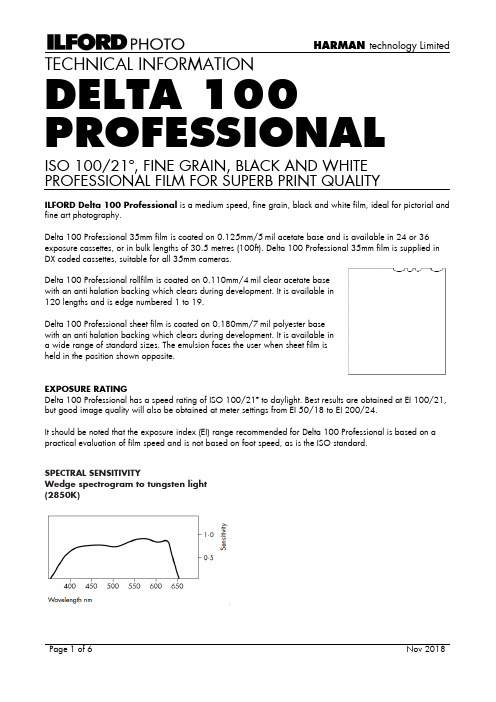
HARMAN technology LimitedTECHNICAL INFORMATION DELTA 100PROFESSIONALISO 100/21º, FINE GRAIN, BLACK AND WHITEPROFESSIONAL FILM FOR SUPERB PRINT QUALITYILFORD Delta 100 Professional is a medium speed, fine grain, black and white film, ideal for pictorial and fine art photography.Delta 100 Professional 35mm film is coated on 0.125mm/5-mil acetate base and is available in 24 or 36 exposure cassettes, or in bulk lengths of 30.5 metres (100ft). Delta 100 Professional 35mm film is supplied in DX coded cassettes, suitable for all 35mm cameras.Delta 100 Professional rollfilm is coated on 0.110mm/4-mil clear acetate base with an anti-halation backing which clears during development. It is available in 120 lengths and is edge numbered 1 to 19.Delta 100 Professional sheet film is coated on 0.180mm/7-mil polyester base with an anti-halation backing which clears during development. It is available in a wide range of standard sizes. The emulsion faces the user when sheet film is held in the position shown opposite.EXPOSURE RATINGDelta 100 Professional has a speed rating of ISO 100/21º to daylight. Best results are obtained at EI 100/21, but good image quality will also be obtained at meter settings from EI 50/18 to EI 200/24.It should be noted that the exposure index (EI) range recommended for Delta 100 Professional is based on a practical evaluation of film speed and is not based on foot speed, as is the ISO standard.SPECTRAL SENSITIVITYWedge spectrogram to tungsten light (2850K)FILTER FACTORSDelta 100 Professional film may be used with all types of filters (eg colour, polarising and neutral density filters) in the usual way. Follow the instructions given by the filter manufacturer.The exposure increase in daylight may vary with the angle of the sun and the time of day. In the late afternoon or the winter months, when daylight contains more red light, green and blue filters may need slightly more exposure than usual.Cameras with through-the-lens metering will usually adjust the exposure automatically when using filters. With some automatic exposure cameras, the correction given for deep red and orange filters can produce negatives under exposed by as much as 1½ stops.MAKING LONG EXPOSURESFor exposures between 1 and 1/10 000 second, no adjustments are needed for reciprocity law failure.When exposures longer than 1 second are given, Delta 100 Professional, along with other films, needs to be given more exposure than indicated by a meter. Use the graph tocalculate the increased exposure time which should be given once the measured time is known.The graph is based on the formulae Ta = Tm 1.26Ta = Adjusted Time Tm = Measured TimeCHOOSING THE BEST ILFORD DEVELOPER FOR THE JOB Manual processing Spiral tank, dish/tray, deep tank Including rotary processorsLiquid Powder Best overall image quality ILFOTEC DD-X ID-11 (stock)Finest grain (EI 100/21) Finest grain (EI 50/18) ILFOTEC DD-X ILFOTEC DD-X PERCEPTOL (1+1) PERCEPTOL (stock) Maximum sharpness ILFOTEC HC (1+31) ID-11 (1+3)Maximum film speed (EI 200/24) ILFOTEC DD-X MICROPHEN (stock) Economy ILFOTEC LC29 (1+29) ID-11 (1+3)MICROPHEN (1+3) One-shot convenience ILFOSOL 3 (1+14) ILFOTEC DD-X ID-11 (1+1)MICROPHEN (1+1) Replenishable ILFOTEC DD-XID-11Machine Processing Dip and dunk ILFOTEC DDBest overall image quality (liquid) and long tank life Short leader ILFOTEC RT RAPID Rapid processing, best overall image quality and long tank life Roller transportILFOTEC RT RAPID Rapid processingDEVELOPMENT TIMESThe table below gives development times for both manual and machine processing Delta 100 Professional. These times will produce negatives of average contrast suitable for printing in all enlargers The development times are intended as a guide and may be altered if a different result is needed.For manual processing in spiral tanks and deep tanks, the development times are based on intermittent agitation. Where continuous agitation is used for manual processing (as in a dish/tray or with some types of developing tank), reduce these times by up to 15%. For use in rotary processors without a pre-rinse, reduce the spiral tank development times by up to15%. A pre-rinse is not recommended as it can lead to uneven processing.35mm and Roll FilmILFORD developer Dilution Meter settingEI 50/18 EI 100/21 EI 200/24Spiral tank, deep tank, dip and dunk machines (min/20o C/68o F)ILFOTEC DD-X1+4810½ 12½ILFOSOL 31+9–5–1+14–7½–ILFOTEC HC1+31568ILFOTEC LC291+195681+295½7½10ID-11stock78½10½1+1 1011131+3 1520–MICROPHEN stock–6½81+1–10141+3–1420PERCEPTOL stock 1215–1+1 1317–1+3 1622–Non-ILFORD DevelopersAcufine stock––5½Rodinal1+2579–1+50 1014–Kodak D-76stock7 9 111+1 9½ 12 141+3 14 22 –Kodak HC-110B5 6 8 Kodak T-Max1+4 6 7 8 Tetenal Ultrafin1+10–681+20– 9½ 11½ Tetenal Ultrafin Plus1+4–5 7 Kodak Xtol stock6½ 7½ 9½Dip and dunk machines (min/24o C/75o F)ILFOTEC DD1+48 9½ 12½Kodak T-Max RS stock 5 6 8 Kodak Xtol stock–6½ 9½ ILFOLAB FP40, roller transport and short leader machines (sec)ILFOTEC RT RAPID1+1+2/26ºC/79o F–40501+1+5/26ºC/79o F40 56 75PROCESSINGDevelopment TimesIf Delta 100 Professional has beeninadvertently exposed at settings below EI 50/18 or above EI 200/24, thefollowing guide will ensure usable negatives are obtained. Obviously, thequality of negatives processed in this waywill not be so high as conventionallyprocessed ones.Note Development times may need adjusting to suit individual processing systems and working practices. If an established system is producing good results, adjust the development times until the desired contrast level is obtained. Development times in other manufacturers’ developers are included for your convenience and are only a general guide. Other manufacturers can and do change their product specifications from time to time, and the development times may change as a result.Processing at Different TemperaturesDelta 100 Professional film can be processed over a range of temperatures. Development times at temperatures other than 20°C/68°F may be calculated from the chart below. For example, if 4 minutes at 20°C/68°F is recommended, the time at 23°C/73°F will be 3 minutes and the time at 16°C/61°F will be 6 minutes.CHARACTERISTIC CURVE100 DELTA Professional roll film developed in ILFORD ID-11 stock for 8½ minutes at 20ºC/68ºF with intermittentagitation. This curve is also representative of the 35mm and sheet film formats. Manual Processing (min @ 20°C/68°F) – accidental exposure only Ilford Developer Dilution Meter SettingEI 25/15 and below EI 400/27and above Microphen Stock - 10Perceptol Stock9 -PROCESSINGDELTA 100 Professional can be processed in all types of processing equipment including spiral tanks, rotary processors, dishes/trays, deep tanks and automatic processors. Standard capacity figures and replenishment rates can be maintained. When fixing DELTA 100 Professional however, slightly longer times than used with conventional film are recommended for best results.Safelight recommendationsHandle Delta 100 Professional film in total darkness.AgitationIntermittent agitation is recommended for use in spiral tanks and deep tanks. With spiral tanks, invert the tank four times during the first 10 seconds, then invert the tank four times again during the first 10 seconds of each further minute. Otherwise, follow the recommendations given by the processing equipment manufacturer. Continuous agitation is recommended in dishes/trays by rocking the dish/tray.Stop, fix, wash and rinseFor best results it is recommended that all process solutions are kept at the same temperature or at least within 5ºC (9ºF) of the developer temperature.Stop BathAfter development the film can be rinsed in water but we recommend that an acid stop bath is used such as ILFORD ILFOSTOP (with indicator dye). ILFOSTOP is also recommended for all machine processing applications. When tanks or dishes (trays) of process solutions are in use a stop bathimmediately stops development and reduces carry over of excess developer into the fixerbath. This helps to maintain the activity and prolong the life of the fixer solution.The process time given is the minimum required, if necessary, a longer time may be used and should not cause any process problems provided it is not excessive. FixThe recommended fixers are ILFORD RAPID FIXER or ILFORD HYPAM FIXER.WashWash the films in running water for 5–10 minutes at a temperature within 5ºC (9ºF) of the process temperature. Or see note below for greater economy when using spiral tanks.Note: For spiral tank use, the following method of washing is recommended. This method of washing is faster, uses less water yet still gives negatives suitable for long term storage.After fixing, fill the spiral tank with water at the same temperature, +/– 5ºC (9ºF), as the processing solutions and invert it five times. Drain the water away and refill. Invert the tank ten times. Once more drain the water away and refill. Finally, invert the tank twenty times and drain the water away.ILFORD ILFOSTOP Dilution 1+19 Temperature Range 18–24ºC (64–75ºF) Time (sec) at 20ºC (68ºF) 10 Capacity (films per litre, unreplenished) 15x (135-36) ILFORD RAPID OR HYPAM FIXERS Dilution 1+4 Temperature Range 18–24ºC (64–75ºF) Time (mins) at 20ºC (68ºF) 2-5 Capacity (films per litre, unreplenished) 24x (135-36)RinseFor a final rinse use ILFORD ILFOTOL wetting agent added to water, it helps the film to dry rapidly and evenly. Start by using 5ml per litre of rinse water (1+200), however the amount of ILFOTOL used may need some adjustment depending on the local water quality and drying method. Too little or too much wetting agent can lead to uneven drying. Remove excess rinse solution from the film before drying.DryingTo avoid drying marks, use a clean squeegee or chamois cloth to wipe Delta 100 Professional film before hanging it to dry. Dry Delta 100 Professional at 30–40°C/86-104°F in a drying cabinet or at room temperature in a clean dust-free area.STORAGEStore Delta 100 Professional in a cool (10–20°C/50-68°F), dry place in its original packaging.FP4 Plus may be stored in a fridge/freezer but allow plenty of time for the film to acclimatise prior to use.Exposed filmOnce exposed, process Delta 100 Professional as soon as practical.Exposed films should always be stored in cool, dry conditions - as recommended above.NegativesStore processed negatives in a cool (10–20°C/50-68°F), dry place, in the dark. Suitable storage sleeves include those made of cellulose triacetate, Mylar, paper (pH6.5–7.5) or inert polyester.A wide range of fact sheets is available which describe and give guidance on using ILFORD PHOTO products. Some products in this fact sheet might not be available in your country.HARMAN technology Limited, ILFORD Way, Mobberley,Knutsford, Cheshire WA16 7JL, England。
电镜胶片及医用X光胶片的冲洗条件及相关参数
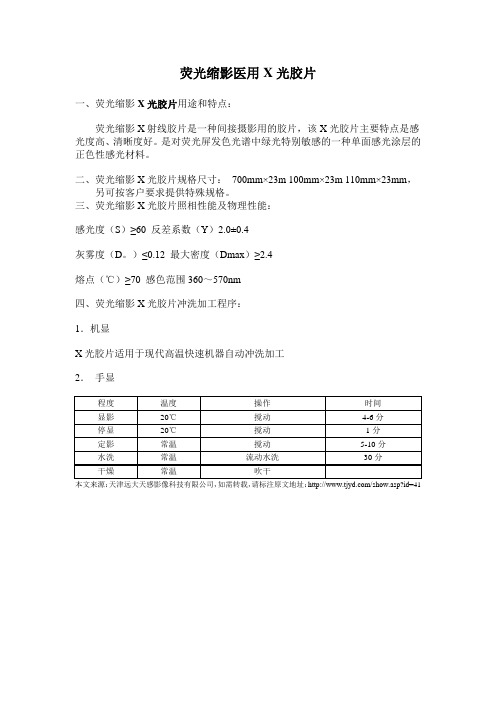
荧光缩影医用X光胶片一、荧光缩影X光胶片用途和特点:荧光缩影X射线胶片是一种间接摄影用的胶片,该X光胶片主要特点是感光度高、清晰度好。
是对荧光屏发色光谱中绿光特别敏感的一种单面感光涂层的正色性感光材料。
二、荧光缩影X光胶片规格尺寸:700mm×23m 100mm×23m 110mm×23mm,另可按客户要求提供特殊规格。
三、荧光缩影X光胶片照相性能及物理性能:感光度(S)≥60 反差系数(Υ)2.0±0.4灰雾度(D。
)≤0.12 最大密度(Dmax)≥2.4熔点(℃)≥70 感色范围360~570nm四、荧光缩影X光胶片冲洗加工程序:1.机显X光胶片适用于现代高温快速机器自动冲洗加工2.手显本文来源:天津远大天感影像科技有限公司,如需转载,请标注原文地址:/show.asp?id=41电镜胶片(电镜底片)新型电镜胶片DJ-II型,可以适用于电子显微镜图像的拍摄,具有速度快,清晰度好,颗粒细,显影宽容度高,灰雾小。
可以使用柯达D19,D72显影加工。
【工业胶片手工冲洗加工】【工业胶片手工冲洗推荐显影液配方】【柯达胶片手工冲洗停显影配方】【柯达胶片手工冲洗定影液配方】注意:配制显、定影液时各种药品按配方顺序依次加入,待前一种药品完全溶化后再加入后一种药品。
【储存与操作】小心操作,避免产生机械损伤本文来源:天津远大天感影像科技有限公司,如需转载,请标注原文地址:/show.asp?id=51天津远大天感影像科技有限公司()系感光材料以及数码成像材料的专业生产厂家,公司的前身是原天津七星感光材料厂,成立于1947年。
后改名为天津感光胶片厂、天津感光材料公司、天津远大感光材料公司。
本公司系天津远大感光材料公司部分改制而成。
原天津感光材料公司系国有大二型企业,拥有职工3000余人,经多次精简,目前在岗职工有1000余人。
拥有4条涂布生产线。
公司目前年生产医用X光胶片150万平方米。
洗片机技术参数
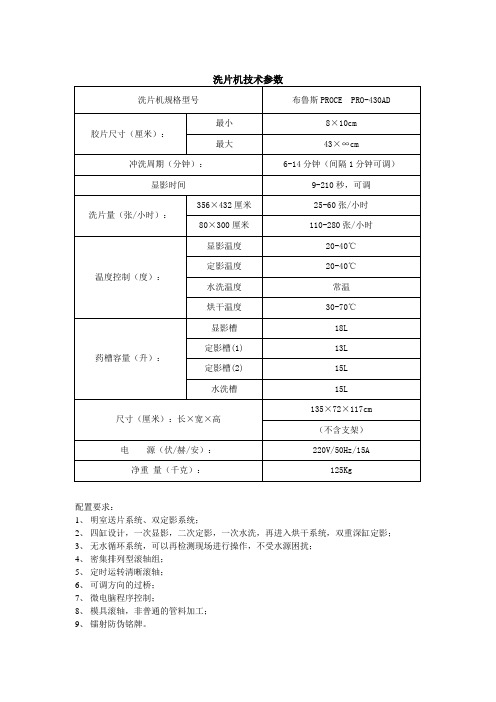
3、无水循环系统,可以再检测现场进行操作,不受水源困扰;
4、密集排列型滚轴组;
5、定时运转清晰滚轴;
6、可调方向的过桥;
7、微电脑程序控制;
8、模具滚轴,非普通的管料加工;
9、镭射防伪铭牌。
20-40℃
定影温度
20-40℃
水洗温度
常温
烘干温度
30-70℃
药槽容量(升):
显影槽
18L
定影槽(1)
13L
定影槽(2)
15L
水洗槽
15L
尺寸(厘米):长×宽×高
135×72×117cm
(不含5A
净重量(千克):
125Kg
配置要求:
1、明室送片系统、双定影系统;
洗片机技术参数
洗片机规格型号
布鲁斯PROCE PRO-430AD
胶片尺寸(厘米):
最小
8×10cm
最大
43×∞cm
冲洗周期(分钟):
6-14分钟(间隔1分钟可调)
显影时间
9-210秒,可调
洗片量(张/小时):
356×432厘米
25-60张/小时
80×300厘米
110-280张/小时
温度控制(度):
显影温度
AMEROYAL C100
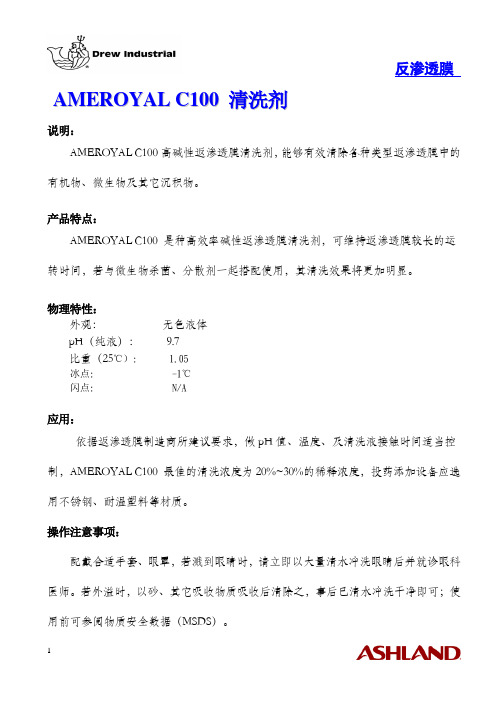
A M E R O Y A L C100清洗剂
说明:
AMEROYAL C100高碱性返渗透膜清洗剂,能够有效清除各种类型返渗透膜中的有机物、微生物及其它沉积物。
产品特点:
AMEROYAL C100 是种高效率碱性返渗透膜清洗剂,可维持返渗透膜较长的运转时间,若与微生物杀菌、分散剂一起搭配使用,其清洗效果将更加明显。
物理特性:
外观:无色液体
pH(纯液):9.7
比重(25℃): 1.05
冰点: -1℃
闪点: N/A
应用:
依据返渗透膜制造商所建议要求,做pH值、温度、及清洗液接触时间适当控制,AMEROYAL C100 最佳的清洗浓度为20%~30%的稀释浓度,投药添加设备应选用不锈钢、耐温塑料等材质。
操作注意事项:
配戴合适手套、眼罩,若溅到眼睛时,请立即以大量清水冲洗眼睛后并就诊眼科医师。
若外溢时,以砂、其它吸收物质吸收后清除之,事后已清水冲洗干净即可;使用前可参阅物质安全数据(MSDS)。
包装:ANEROYAL C100的包装为25公升装。
敬告客户及用户:
Drew Industrial Chemical为维謢客户及用户使用此产品时之安全,备有”产品安全须知”(MSDS)。
我们建议您随时依需要就近向Drew Industrial Chemical各地之分公司或代理索取此数据,并于使用此产品前详细及熟知此产品使用上的各项安全须知。
多谢合作!。
ECN-2 冲洗
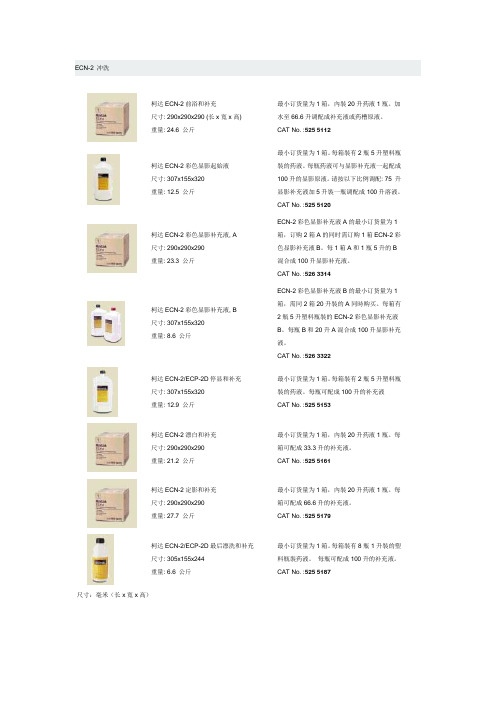
ECN-2 冲洗柯达ECN-2前浴和补充尺寸: 290x290x290 (长x寬x高) 重量: 24.6 公斤最小订货量为1箱,內裝20升药液1瓶。
加水至66.6升调配成补充液或药槽原液。
CAT No. :525 5112柯达ECN-2彩色显影起始液尺寸: 307x155x320重量: 12.5 公斤最小订货量为1箱。
每箱裝有2瓶5升塑料瓶裝的药液。
每瓶药液可与显影补充液一起配成100升的显影原液。
请按以下比例调配: 75 升显影补充液加5升裝一瓶调配成100升溶液。
CAT No. :525 5120柯达ECN-2彩色显影补充液, A 尺寸: 290x290x290重量: 23.3 公斤ECN-2彩色显影补充液A的最小订货量为1箱,订购2箱A的同时需订购1箱ECN-2彩色显影补充液B。
每1箱A和1瓶5升的B 混合成100升显影补充液。
CAT No. :526 3314柯达ECN-2彩色显影补充液, B 尺寸: 307x155x320重量: 8.6 公斤ECN-2彩色显影补充液B的最小订货量为1箱,需同2箱20升裝的A同時购买。
每箱有2瓶5升塑料瓶裝的ECN-2彩色显影补充液B。
每瓶B和20升A混合成100升显影补充液。
CAT No. :526 3322柯达ECN-2/ECP-2D停显和补充尺寸: 307x155x320重量: 12.9 公斤最小订货量为1箱。
每箱裝有2瓶5升塑料瓶裝的药液。
每瓶可配成100升的补充液CAT No. :525 5153柯达ECN-2漂白和补充尺寸: 290x290x290重量: 21.2 公斤最小订货量为1箱,內裝20升药液1瓶。
每箱可配成33.3升的补充液。
CAT No. :525 5161柯达ECN-2定影和补充尺寸: 290x290x290重量: 27.7 公斤最小订货量为1箱,內裝20升药液1瓶。
每箱可配成66.6升的补充液。
CAT No. :525 5179柯达ECN-2/ECP-2D最后漂洗和补充尺寸: 305x155x244重量: 6.6 公斤最小订货量为1箱。
- 1、下载文档前请自行甄别文档内容的完整性,平台不提供额外的编辑、内容补充、找答案等附加服务。
- 2、"仅部分预览"的文档,不可在线预览部分如存在完整性等问题,可反馈申请退款(可完整预览的文档不适用该条件!)。
- 3、如文档侵犯您的权益,请联系客服反馈,我们会尽快为您处理(人工客服工作时间:9:00-18:30)。
Stop bath. After development, although it is possible to simply rinse the film in water, we advise using a stop h such as ILFORD ILFOSTOP (This contains an indicator dye in it). ILFORD ILFOSTOP is suitable for both machine and manual processing applications. When stop bath is used, it immediately stops development and reduces carry-over of excess developer into the fixer bath. This will help to maintain the activity and prolong the life of the fixer solution. When using ILFORD ILFOSTOP bath, we advise it be used as follows:- Ilfostop at 1+19 dilution / temperature range of 18-24°C (64-75°F) - for 10 seconds. Note, this 10 second time is the minimum time required. If a longer time is used, it is not anticipated that it will lead to any processing problems provided the time increase is not excessive. We advise processing a maximum of 15 x 35mm 36 exposure films in 1L unreplenished stopbath.
The films 100 ISO speed rating was established from processing in ID-11 developer at 20°C / 68°F with intermittent agitation in a spiral tank.
Once a film is exposed, we advise to have it processed as soon as practical. However, images on exposed but unprocessed films will not degrade for several months provided they are stored as we advise in cool, dry conditions.
USER ADVICE
STORAGE OF UNEXPOSED, AND EXPOSED/UNPROCESSED FILMS We advise films be stored in a cool dry place, and when possible (prior to exposure) in its original packaging. Advisable temperatures – between 10-20°C / 50-68°F.
Fixers. We recommend using either ILFORD HYPAM or RAPID liquid fixers. ILFORD RAPID fixer must not be used with fix hardeners as it is not compatible with them, but ILFORD HYPAM fixer is compatible with fix hardeners. Generally for most applications, modern camera films are sufficiently hardened at manufacture, so additional hardening from a fixer hardener is not usually needed or recommended for processing in spiral tanks, dishes/trays, deep tanks, rotary processors, dip and dunk (hanger) machines and short leader card processors, unless the processing temperature is above 30ºC (86ºF), or poor drying performance is being experienced. But, to minimise the risk of physical damage, a fixer hardener may be needed when using roller transport processors. Use of a fix hardener requires recommended fix and wash times to be extended - so depending on film / processing conditions, hardened fix times need to be between 4-10 minutes followed by a wash time of 10-20 minutes in running water. When using ILFORD fixers as non hardening fixers, we advise they be used as follows:- ILFORD HYPAM or RAPID at 1+4 dilution / temperature range of 18-24°C (64-75°F) - for 2-5mins. We advise processing a maximum of 24 x 35mm 36 exposure films in 1L unreplenished fixer.
AVAILABILITY The film is available in 35mm format in 24 and 36 exposure lengths, and in bulk lengths of 30.5m.
KEY PROPERTIES - Mid speed film – rated at ISO 100 / 21°. - Capable of coping with a wide range of general indoor and outdoor photography applications. - Enables good sharpness. - Fine grain. - Broad tonal range with good contrast. - Broad exposure latitude. - Compatible with many developers.
Page 1 of 3
January 2009
KENTMERE 100
PROCESSING / AGITATION Kentmere 100 is suitable for processing in most types of processing equipment – including spiral tanks, rotary processors, dishes/trays, deep tanks and automatic processors. Developers. A wide range of developers are suitable to use. Developer choices and their guide process times / temperatures and dilutions are all shown in the table on page 3.
EXPOSURE Kentmere 100 has a speed rating of ISO 100 / 21° (100ASA, 21DIN, EI 100/21°) to daylight. Although it is possible to rate the film at 50/18° and 200/24°, the film performs at its optimum when rated at 100ASA. When rated at any alternate suggested ASA ratings, quality does diminish in terms of grain and sharpness. If any alternate speed settings to 100ASA are to be used, it is therefore advisable that tests be carried out first to ensure these alternate speeds are suitable.
FILTER FACTORS Kentmere 100 can be used with all standard types of filters (colour, polarising and neutral density filters). It is advised that the filter manufacturers instructions are followed in terms of any exposure compensation factors needed. For eg, it is likely that red or orange filters will require compensation, or they are likely to result in under-exposed negatives (by up to 11/2 stops) if the cameras automatic exposuring is used alone. Filter manufacturers do usually indicate what correction factor will be needed, but failing that, it would be advisable that a user bracket exposes/tests - when using filters.
